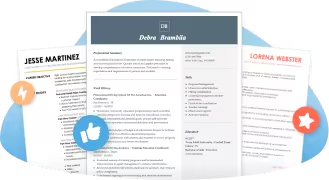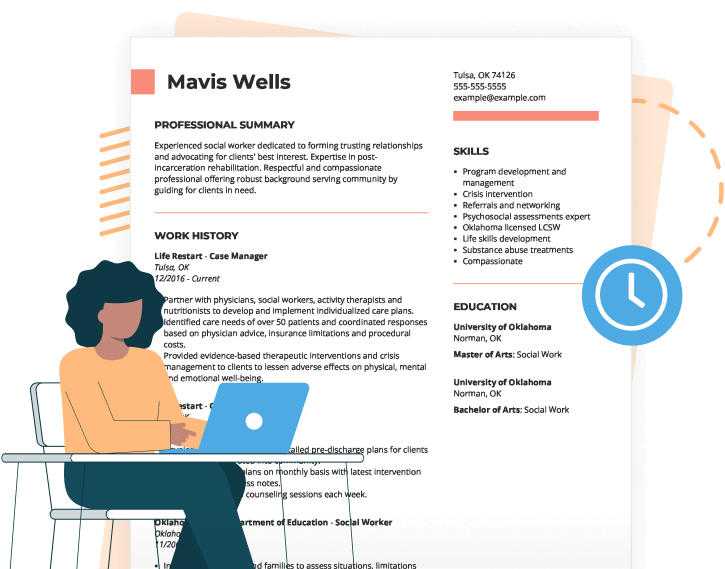Featured Resume Examples
More top-requested fitness and nutrition resume examples are for Zumba instructor, pilates instructor and yoga instructor. Looking for additional roles in this category? Scroll on, we have plenty more below.
Search Fitness Nutrition Jobs
Fitness Nutrition Resumes by Job Title
Find the resume example you need by browsing these specific Fitness Nutrition categories:
Nutritionist and Wellness Roles (5)
Personal Trainer Roles (3)
Group Fitness Instructor Roles (20)
Sports and Facilities Management Roles (3)
Cover Letter Examples for Fitness Nutrition Jobs
Job Outlook
It is a great time to be in the fitness and nutrition industry. According to the U.S. Bureau of Labor Statistics, the employment demand for fitness trainers and instructors is projected to increase 15% from 2019 to 2029.
Landing the job you want will require a resume that will engage with recruiters.
To help you achieve this goal, check out our professional writing tips for resumes within the fitness and nutrition industry such as nutritionist and wellness, personal trainer, group fitness instructor or sports and facilities management.
3 Tips for Writing Fitness and Nutrition Resumes
Choose the right format for your resume
From working in the fitness and nutrition industry, you’re well aware of the importance of having your equipment ready and set up properly before your client begins.
Well, the same goes for resumes. While the majority of resumes are going to consist of the same parts, the way that you organize these parts is called its format.
The format you should choose for your resume depends on how long you’ve worked in the fitness and nutrition industry.
If at this point, you have been training clients for over five years, you should use what’s called a chronological format, the most common type of resume format. With clean and structured templates such as the Standard or Modern, you will have a professionally tailored resume in seconds.
Chronological formats emphasize your work history, so this is a great resume format for fitness and nutrition specialists with an active employment history.
However, if you’re fresh out of school, you should choose another format that better suits your level of experience.
While functional formats allow you to focus more on your skills and training than your work experience. If you have fewer than two years’ experience as a fitness and nutrition professional, this format is for you.
If you’ve worked for more than two years in a fitness and nutrition role, but less than five total, you should use the hybrid format. This type of resume is a combination of the functional and a chronological formats with the right balance to your work history and skills.
It’s perfect if for instance, maybe you have six years experience working as a gym receptionist, but only two working as a personal trainer. It shows growth without hyperextending your two years of active trainer experience.
Promote your skills
No two roles in fitness and nutrition are identical, however, there are skills that are considered useful for every single position across the field.
It’s essential that you include a few skills on your resume that highlight your strengths.
Sought-after skills for fitness and nutrition include:
- AED/CPR
- First-Aid
- Physical assessment
- Personal training techniques
- Designing customized exercise programs
- Personal training software
- Anatomy
- Kinesiology
- Physiology
- Safety techniques
- Nutritional assessment
- Coaching
- Verbal and physical communication
- Counseling
- Motivational skills
- Mentorship
- Individualized meal plans
- Sports medicine
- Fitness assessment
- Athletics
- Creativity
- Social media skills
- Organizational skills
- Self management
- Problem-solving
Incorporate six to eight critical skills into your resume that describe your top attributes.
Pay close attention to the job posting or ad — the phrases and keywords are clues to exactly what the employer is looking for in a candidate. Identify key phrases and use them to describe your skills.
Use a template to make your resume look clean
In the fitness and nutrition world, it’s all about appearance and it’s no different with your resume.
If your resume doesn’t look clean and easy-to-read with all the design elements working in harmony, you won’t make the cut to an interview.
That’s why you should use a resume template, created by professional designers to make your resume look great and up-to-date.
You’re an expert on how to make people reach their fitness and nutrition goals — leave it to the expert designers to help you feel confident about your resume.
JobHero has loads of great resume templates that you can use — pick one you like and input your information. JobHero also features a Resume Builder that lets you choose from a selection of templates, and makes it quicker and easier to create a next-level resume.
The builder auto-suggests content based on how to phrase your fitness, coaching or management work history to help make each bullet point impactful and engaging.
The Resume Builder is a great tool to showcase your experience with elements that will make your resume stand out.
The builder allows you to tailor your resume effortlessly with power words and templates that will hold the recruiters’ attention.
FAQ
What should I put on my resume for fitness and nutrition?
As with any resume, you will need the five main sections: contact information, professional summary or objective statement, skills, work history and education.
The main selling points of your fitness and nutrition resume should be found in your skills and work experience sections.
They should take up the most space on your resume because that’s where you’re going to convince employers you are the right person for the job.
It’s good practice to try to put numbers in your resume so that employers get a full scope of what you’re capable of as a fitness and nutrition professional.
For example, for a work history describing a Zumba instructor, you could include figures like these:
Save the stretching for yoga — obviously you want to use flattering numbers, but never lie on your resume. It will only backfire to set unrealistic standards for yourself.
How should I include a fitness and nutrition portfolio on a resume?
The fitness and nutrition industry creates the perfect opportunity to build a portfolio that will highlight your work.
Have samples of your accomplishments on social media or online platforms.
You can be strategic and include links to your visuals on your cover letter and resume. This will direct recruiters to your work for a closer look of your methods and results.
For your resume, you could either add the link underneath your email address in the contact section, or create an online portfolio section that includes the link at the bottom of your resume.
Something that looks like this:
Online Fitness and Nutrition Portfolio
www.yournamehere.com/fitness
See more of my work at JackFit__415 @ Instagram
Strengthen your cover letter with samples of your work by including the links to your online fitness portfolio. This will allow the employer to not only read about you, but also to see results.
How do I list education on a fitness and nutrition resume?
Many roles in fitness and nutrition will require you to have your state-approved license in specialized education.
While some positions may be entry-level such as a receptionist or spa assistant and don’t require certifications of any kind, it’s still going to help you to include your education.
To list your education, include the name of the institution you attended, its city and state, and if you graduated, your major(s).
Here’s an example:
Coastline College Santa Cruz, CA
Associate Degree, Fitness and Nutrition
If you have graduated from college, it’s not advised to include your high school education.
Take note: It used to be standard to list the year you graduated. However, this is now discouraged because it can give an employer an indication of your age which can lead to potential hiring bias.
You should only list the dates you attended a school if you did not graduate as the means to show how long you attended.
What kind of work experience should I put on a fitness and nutrition resume?
Try to keep all the work experience you include in a resume focused on fitness and nutrition.
The closer your work history aligns with the new role, the more hiring managers are apt to give you serious consideration.
If you’re fresh out of school or new to fitness and nutrition you could include work from other industries, but only if there are necessary skills culled from those jobs that would apply to work in fitness and nutrition.
For example, if you worked in other jobs that demanded high levels of physical stamina, manual dexterity, customer service or rapport building, include these skills on your resume.
Don’t be afraid to use work experience that you did as an internship, understudy or assistant even if it was unpaid. It will pay off to include it in your resume.
Should I include a cover letter with my fitness and nutrition resume?
Yes! Even if it’s not requested in the job posting, pairing a cover letter with your resume will strengthen your summary of experience.
Currently, a cover letter is the professional standard. It will put you ahead of the competition and make you stand out from other candidates.
A cover letter also creates a fresh opportunity to further explain your skill sets and work performance.
Furthermore, a cover letter helps you set the tone and engage with the employer so that they are eager to contact you for an interview.
To get started, check out our library of fitness and nutrition cover letter samples.






